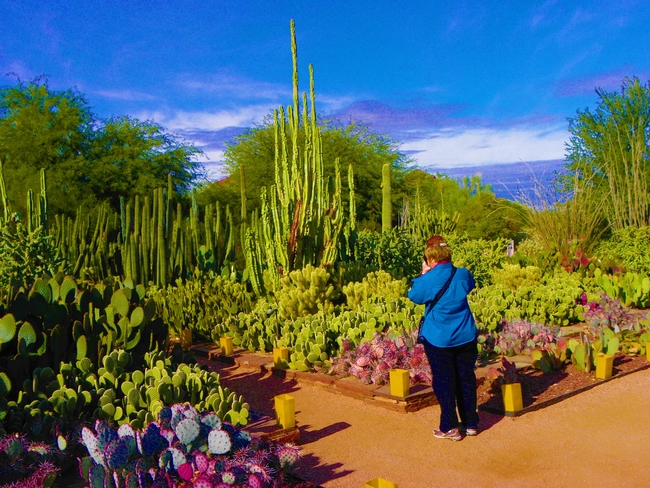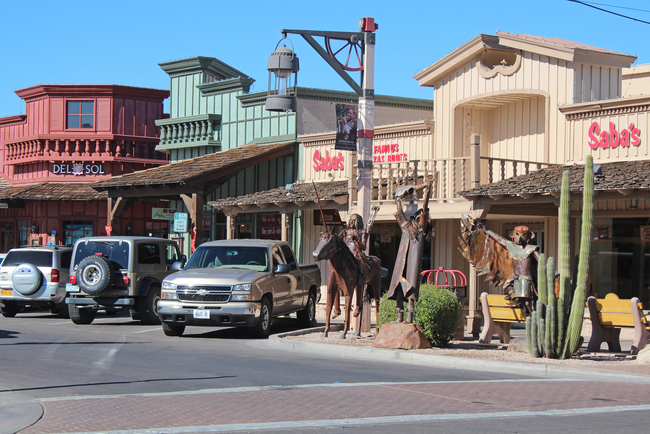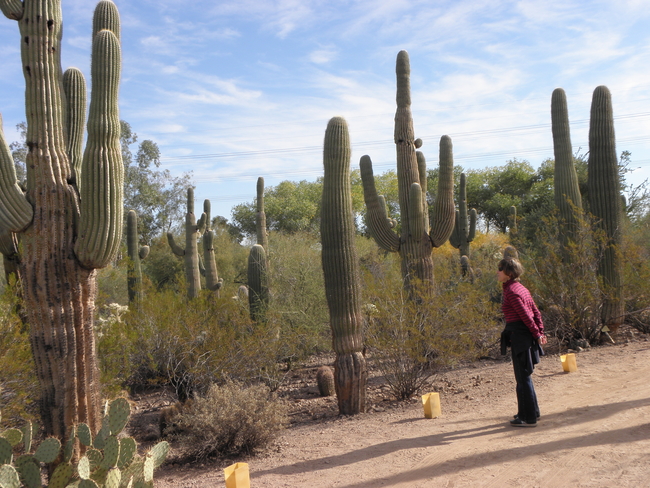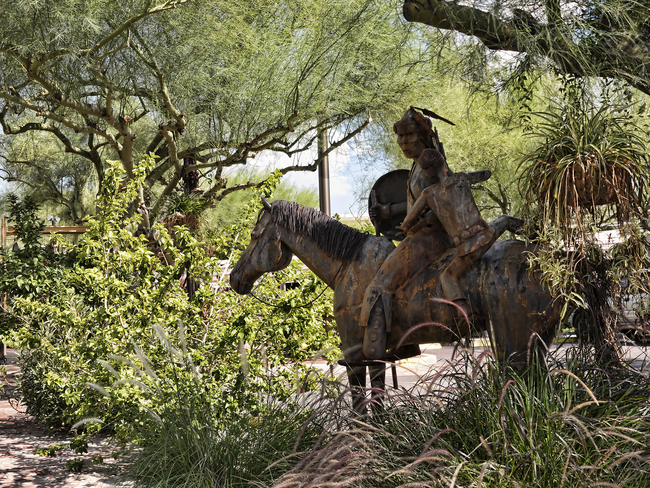

Bejeweled women dressed in the latest fashions stroll into the likes of Gucci, Neiman Marcus and Tiffany, intent on adding to their chic wardrobe and collection of costly adornments. Not far away, my wife Fyllis, wearing blue jeans, boots and a cowgirl hat, is learning to lasso cattle.
My afternoon is spent exploring a rugged wilderness of giant cactus, towering mesas and vast stretches of barren landscape. There I discover that what appears to be dry desert is home to plants and animals that have adapted to life in searing temperatures and little rainfall.
The first impression Fyllis and I had during a visit to Scottsdale, Arizona, was the diversity of attractions in and around that small city. The shopping experience alone provided an introduction to the something-for-everyone variety.
World-famous stores are neighbors to specialty shops and boutiques. In a city whose slogan is “The West’s Most Western Town,” it’s no surprise to pass store after store selling cowboy hats, boots and everything worn between them.

Reminders of Cowboys and Native Americans Abound in Scottsdale, Arizona
Of course, where there were cowboys there usually were Native Americans, and their influence remains strong. One shop alone, the River Trading Post, sells Native American art and artifacts created by people from more than 70 tribal nations.
The cowboy influence also remains strong, as Fyllis learned while playing the role of a working cowgirl. Part of that experience included a horseback ride.
The trail in the Sonoran Desert over which Fyllis rode, and the area that I had explored, represent just a sliver of that vast wilderness. It stretches through Arizona, California and northern Mexico, covering an expanse about the size of Colorado.
Among its many attributes, that vast wilderness is a cactus heaven. The majestic saguaro (pronounced suh-WAHR-oh) can grow to 50 feet tall and live as long as 200 years. They grow wild only in the Sonoran Desert, and the saguaro blossom is the official state flower.

Numerous other species of cactus also find the Sonoran’s arid conditions to their liking. Some colorful names – like purple prickly pear, organ pipe and teddy-bear cholla – add to their appeal.
Nature and History Tell Intriguing Stories Around Scottsdale, Arizona
One of many fascinating desert stories is how both animal and plant life have adapted to its harsh environment. What appears to be a seemingly uninhabitable wasteland is home to some 60 mammals, 350 kinds of birds, over 100 types of reptiles and even 30 species of fish. Their survival techniques are among Mother Nature’s more intriguing stories.
For example, many animals sleep in shade during hot days and venture out to feed during cooler nights. Some small mammals survive primarily on water they get from what they eat. The western banded gecko stashes away both food and water in its long tail for later use when needed.
The desert also is a treasure-trove of human history, ranging from prehistoric ruins and remnants of Native American life to abandoned mining encampments. Some of the desert’s magnificence is captured in sanctuaries and museums.
The McDowell Sonoran Preserve is a mini-wilderness more than 35 times the size of Central Park in New York. It’s home to hundreds of types of plants and animals, and nearly 200 miles of trails.
Entering the more formal Desert Botanical Garden, we exclaimed “Wow” in unison. Never had we realized there are so many different kinds of cactus, each quite beautiful in its own way.
Five loop trails meander through an amazingly varied collection of arid plants from deserts around the world. Each path focuses upon one topic, including plants of the Sonoran, desert wildflowers and conservation.
I found most interesting exhibits of how people learned to live in the hostile environment. Native Americans used a variety of plants, including cactus and mesquite, for food, medicine and other needs.
Fyllis and I paused at a grinding stone to pound mesquite beans into flour, a muscle-tiring exercise that gave us a new appreciation for store-bought bread. We also stooped to step inside a roundhouse of the kind constructed by Native Americans who once inhabited this area of present-day Arizona.

In fact, reminders of American Indians are everywhere. A vast collection of Indian art and artifacts is the main feature at the world-class Heard Museum in nearby Phoenix, which blends seamlessly into Scottsdale, and its satellite location in North Scottsdale. The lovely sculpture and native plant garden at the Scottsdale site is a perfect place to relax and rest following a sightseeing excursion.
The Pueblo Grande Museum and Archaeological Park also is worth a stop and stroll. The complex sits atop remains of a village of the Hohokam people, who lived in the area from about 450 to 1450 AD. They were the first to cultivate the land of the Sonoran Desert, using a vast system of irrigation ditches. Some of those trenches, and an excavated ball court, still are visible today.
Reproductions of pit houses, mud and adobe-covered structures placed in a shallow depression, demonstrate how the dwellings provided insulation against the extremes of desert temperatures.
Scottsdale, Arizona’s Neighborhoods Offer Added Attractions for Visitors
Along with museums, neighborhoods in and around Scottsdale combine interesting historical tidbits with an array of shopping and recreational opportunities. The center of much action is the Old Town neighborhood.
Located on the original site from which the community expanded, it‘s a hub of museums, historic structures, dining, night life and a shopper’s paradise. From cowboy wares to Native American jewelry to international brand-name items, any shopper who can’t find ways to spend money there just isn’t trying.
Old Town also is crammed with many of the city’s more than 100 art galleries. Even the streets serve as an outdoor museum, with dozens of works including a giant lizard, a metal rider astride a bucking horse and a number of less identifiable abstract sculptures on display.

Very different in atmosphere and appeal are tiny enclaves on the outskirts of Scottsdale which caught my fancy. Cave Creek (population about 5,000) was settled in 1870 by miners and ranchers, and served as a stopping point for U.S. Cavalry troops. The town clings stubbornly and proudly to its western heritage, as home to shops selling cowboy gear, several saloons and periodic rodeos.
If Cave Creek keeps alive vestiges of the Old West, the adjacent village of appropriately named Carefree represents the present. It was built as a planned community of homes, some now valued at millions of dollars, which line streets with names like Easy, Tranquil, Ho and Hum. Locals describe this juxtaposition of Old and New West as the “home of cowboys and caviar.”
That same comfortable marriage of old with new, casual with chic is experienced everywhere. It’s common in and around Scottsdale to see men and women wearing jeans and western hats strolling out of shops that would feel comfortable on New York’s Fifth Avenue or Rodeo Drive in Beverly Hills, laden down with high-end purchases.
Some residents refer to a gourmet hamburger restaurant, where the parking lot often is packed with top-of-the-line automobiles, as “Burgers and Bentleys.” For Fyllis and me, this combination of upscale life with a laid-back attitude added to the charm and appeal of Scottsdale.
For more information about Scottsdale, Arizona call (800) 782-1117 or log onto experiencescottsdale.com
Authors: Fyllis Hockman and Victor Block are a husband-wife team of experienced travel journalists who have gallivanted throughout the United States, and to nearly 80 countries around the world, and written about what they have seen, done and learned. Their articles have appeared in newspapers across the country and on websites across the Internet, and they each have won numerous writing awards. They love to explore new destinations and cultures and uncover off-the-beaten-path attractions. Read more of their work at The Rambling Writers
- Broward County, Florida: When the Winter Sun Hides Behind a Cloud - April 16, 2024
- Nature is Neat in Broward County, Florida - April 1, 2024
- Margaritaville: A Time-Honored Memorial to Jimmy Buffett - March 15, 2024
